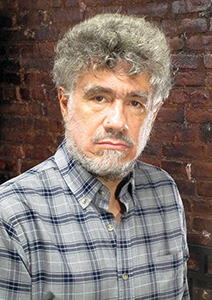Individuals with autism have long had great affinity for and been involved with technology, so it is only fitting that modern technology is becoming of greater value and significance to the autism community. I am able to appreciate this both as an adult on the autism spectrum and as a long-time electronics engineer in research and development. I also belong to the generation of engineers that created many of the technologies that we all use today, and which have had such transformational effects on our society and on the way that many of us live our lives. Personally, I was involved in the design of early prototypes for the digital high-definition television and broadcasting systems that are in use today.

Technology has been a very important part of my life since early infancy, when I became “obsessed” with anything mechanical or electrical and with taking apart and assembling anything that I could get my hands on. Although undiagnosed at the time (the broader autism spectrum would not even be known for many years), this is now recognized as a classic autistic special interest, and a fairly common one at that. I had a number of special interests while growing up, but this was both the strongest and the one which I maintained for the longest time. I figured out how things worked by taking them apart and re-assembling them, eventually learning how to repair them. I especially enjoyed finding old radios, televisions, and other electronic devices, taking them home, and getting them to work. This led to my studying physics and electrical engineering in college, and to a career as an electronics engineer.
Years later, when I was finally diagnosed with Asperger syndrome, I learned that one of the few statistical correlations among people with autism is that they are much more likely to have a close family member in certain occupations, of which engineering is especially common, than are the majority of people. In fact, my father had a degree in electrical engineering. Because my parents divorced very early, though, I barely even knew him and he had no influence on me in this regard. Unlike most people, I did not develop these interests through a role model, as nobody else in my family or environment had even the slightest technical inclination. Instead, I gravitated towards them with no external influence whatsoever. When I informed a half-sister (from my father’s subsequent marriage) of my diagnosis, she told me of her suspicion that he might have been on the spectrum as well. With the new expanded definition of autism, I found that individuals on the spectrum were themselves more likely to be in one of these occupations than was the average person. In other words, I was far from being the only autistic engineer around; there certainly were many others. I even remembered some former co-workers and classmates who, in retrospect, had likely been on the spectrum as well.
During the time since my diagnosis in August of 2000, I have learned about the many ways in which assistive technologies are used to help people with autism. Probably the first of these was the computer keyboard (especially portable and laptop computers), which was of great help to nonverbal individuals with autism, not to mention those with poor coordination or difficulties with handwriting. Along with the proliferation of educational uses for computers, a variety of assistive applications were developed to help children on the spectrum with their challenges, particularly those involving social learning. With the development of even more portable devices like smartphones and tablets, the number of assistive technologies for individuals with autism has exploded. These serve the breadth of the autism spectrum, from severe to mild, as well as the age range from children to adults. In particular, those for organizing time and other resources are of great help to anyone with executive functioning deficits, which many on the autism spectrum have.
Probably the most notable application of technology to help children with autism, however, has been the use of small (under two-foot) human-like robots that I saw exhibited at recent autism conferences. These robots, currently offered as products by such companies as RoboKind and Aldebaran Robotics, are specifically designed to teach social skills to young children on the spectrum, and are very impressive in both their technological capabilities and the receptiveness of children with autism to them. Their various mechanisms are very sophisticated (having many “degrees of freedom” as referred to by engineers) and can emulate a wide range of body movements and facial expressions. As such, they can display a broad repertoire of amazingly human-like behaviors. Most interesting to me, however, was that they were originally developed to train technologists in the field of robotics, until someone brought his small daughter with autism to see the robot and saw that she related to it immediately. This was a significant breakthrough because, up to that time, she had never been able to relate to another human. The robot designs were then adapted for working with children with autism, who generally respond to them much better than they do to humans. Their appeal could even be seen in the response of neurotypical adults, who related to these little robots much as they might to a puppy or a kitten or even a small child.
As significant as the practical uses of modern technologies might be to the autism community, the prospects of learning about, working, and eventually finding employment in technology-related fields is of even greater significance to a substantial part of the autistic population. Most notably, a number of firms have committed themselves to train and employ adults on the autism spectrum in the field of software testing. This area is particularly suitable for individuals with autism, as it involves very repetitive, systematic, highly-focused work to detect subtle coding errors in computer software, and this population is known to often be exceptionally good at finding a variety of mistakes and pointing them out.
Praiseworthy and commendable as such initiatives are, however, I am strongly of the opinion that there is nothing new about individuals with autism working with and even developing technologies – in fact, I believe that this has probably been the case for much if not all of human technological history. I am also convinced that there are a number of occupations that have capitalized on the strengths and talents of many on the spectrum throughout history and up to recent times. The ability to spot errors and correct them is essential for proofreading and the ability to do repetitive and systematic mental work is needed in such occupations as bookkeeping. I am certain that numerous individuals with autism have been employed in these and other related fields. Also, the mechanical talents of many individuals with autism are of great value in the repair, maintenance, and even design of such devices. Consequently, I am once again certain that many individuals on the spectrum have been involved in these areas, both as repairpersons (which I no doubt would have been had I not had the opportunities I did) and as engineers.
Unfortunately, while many technologies have provided great benefits for humanity, some have resulted in great harm as well. The modern age is largely defined by transportation, communication, automation, information, and other technologies that liberated man from the hardships of physical labor, allowed him to travel anywhere in the world and communicate with just about everyone, provided nearly unlimited access to many forms of human knowledge and expression, and generally brought about a quality of life that our ancestors could not even have imagined. Nevertheless, it has also resulted in the most destructive of weapons, ranging from firearms to nuclear weapons, and brought about considerable damage to our environment. What I am proposing here is that modern technology has had both kinds of effects on the autism community as well.
One adverse result of technology has been (especially since the industrial revolution) the disappearance of jobs which had been performed by human workers but were now done by machines, and the very need for which was sometimes eliminated. Most recently, this happened because of dramatic increases in the capabilities of electronic and especially computing and communication technologies (the power of which have grown exponentially over time). These have greatly reduced the need for human labor in a number of areas, particularly those involving repetitive or systematic tasks. While such developments have certainly affected everyone in our society, I strongly believe that individuals with autism, who tend to be especially adept at such tasks, are affected by this in much greater proportion than the general population. In particular, occupations such as proofreading and bookkeeping which require these abilities have been decimated, because the tasks are now performed by computer software such as word processors and spreadsheets. Also, those involving repair and maintenance of mechanical, electrical, and electronic devices are much less needed because these have become so inexpensive that their repair is economically impractical. The result is that many individuals with autism who in the past might have found employment in these areas are no longer able to do so. Unfortunately, the relatively few software testing jobs, beneficial though they certainly are, cannot make up for these huge losses. The result is that unemployment among individuals with autism, who have well-known challenges in finding employment, has greatly increased; it may very well be that many more were employed in the past than is the case today.
If there is any lesson to be learned from the history of technological advances, it is that it is very difficult, if not impossible, to predict what technologies will be developed in even the near future. It is still more difficult to foretell what they will be used for, let alone how they will be used; only the future itself will tell us. Where the autism community is concerned, we can only be certain that, as new technologies continue to come about, they will significantly affect us. The best that we can do is try to understand their effects so that the community can benefit from them as much as possible, but is also able to address any adverse consequences that they might bring.
For more information, Karl can be reached at kwittig@earthlink.net.





